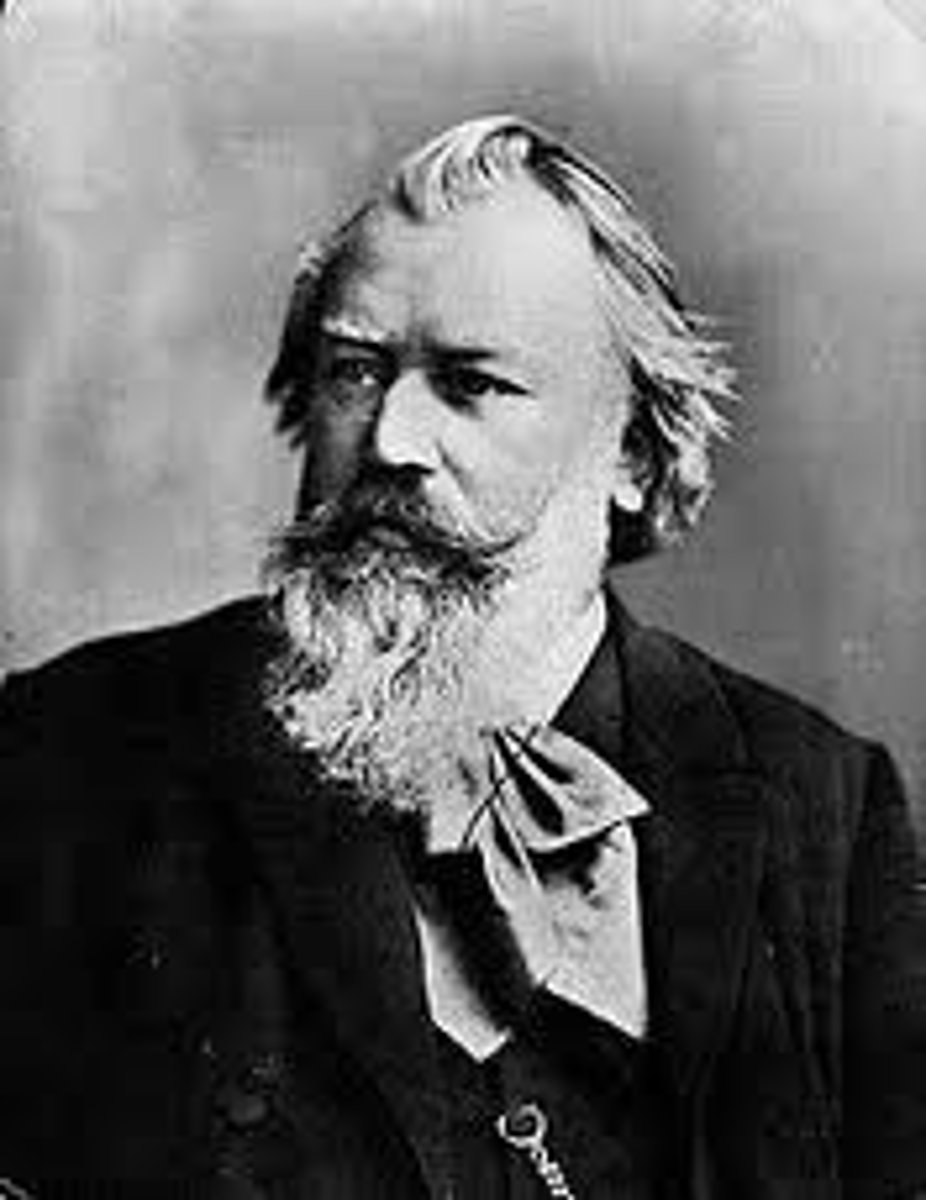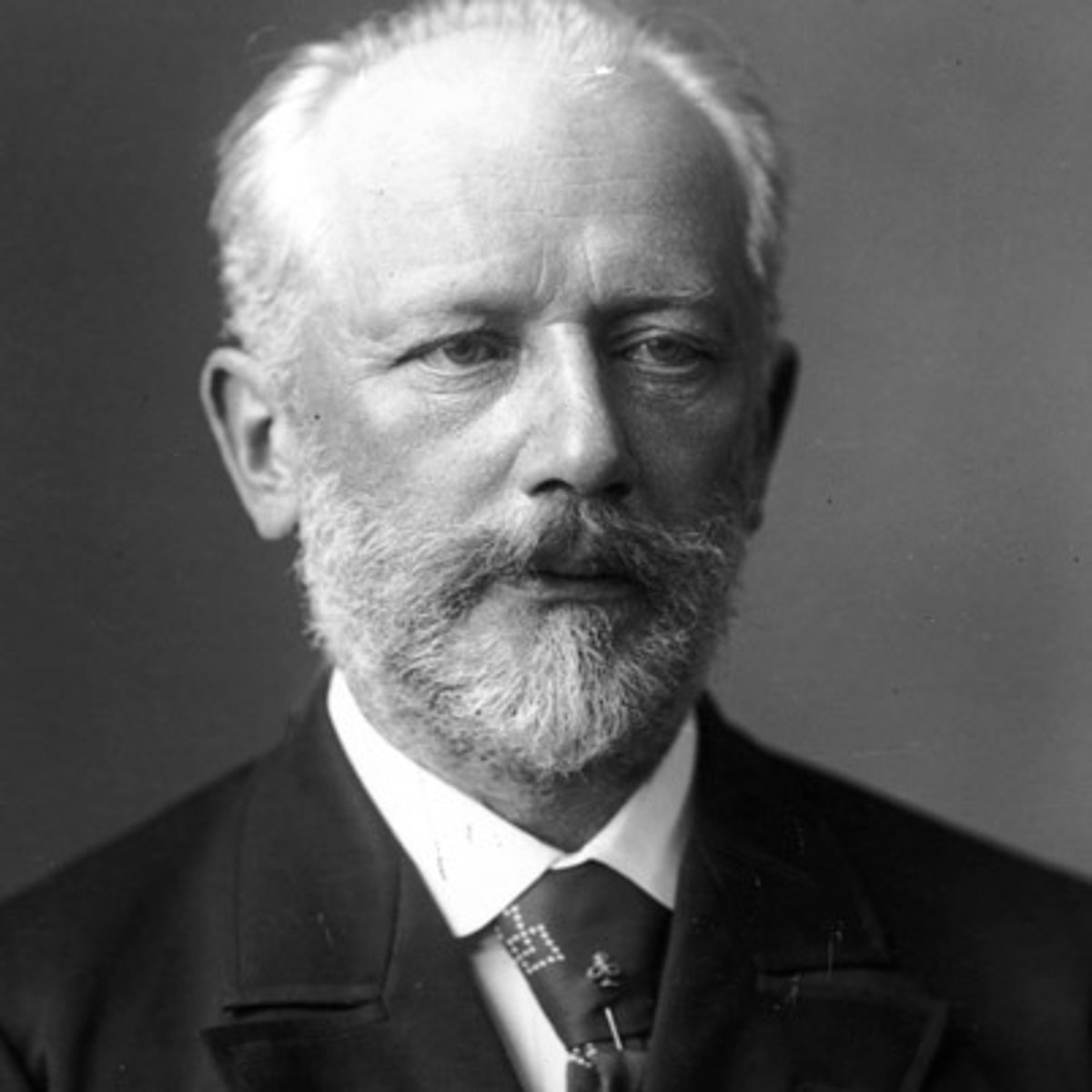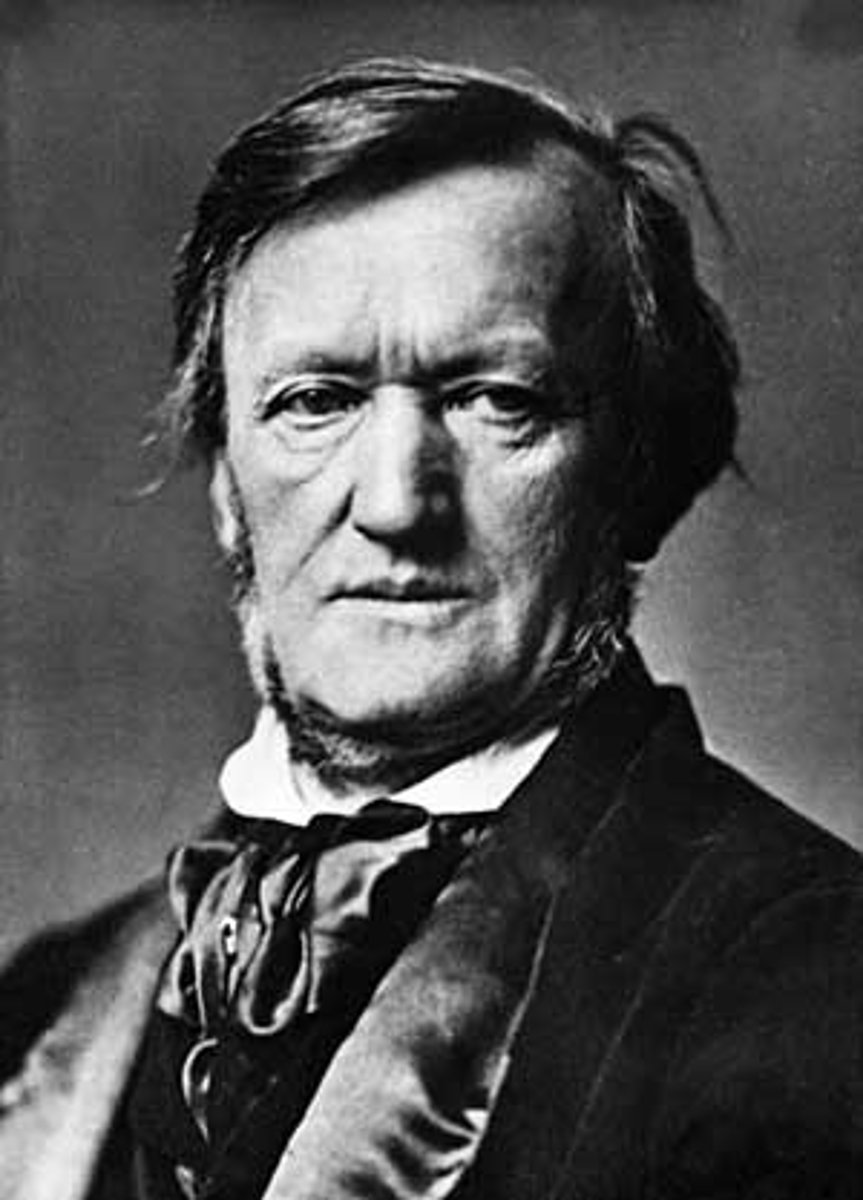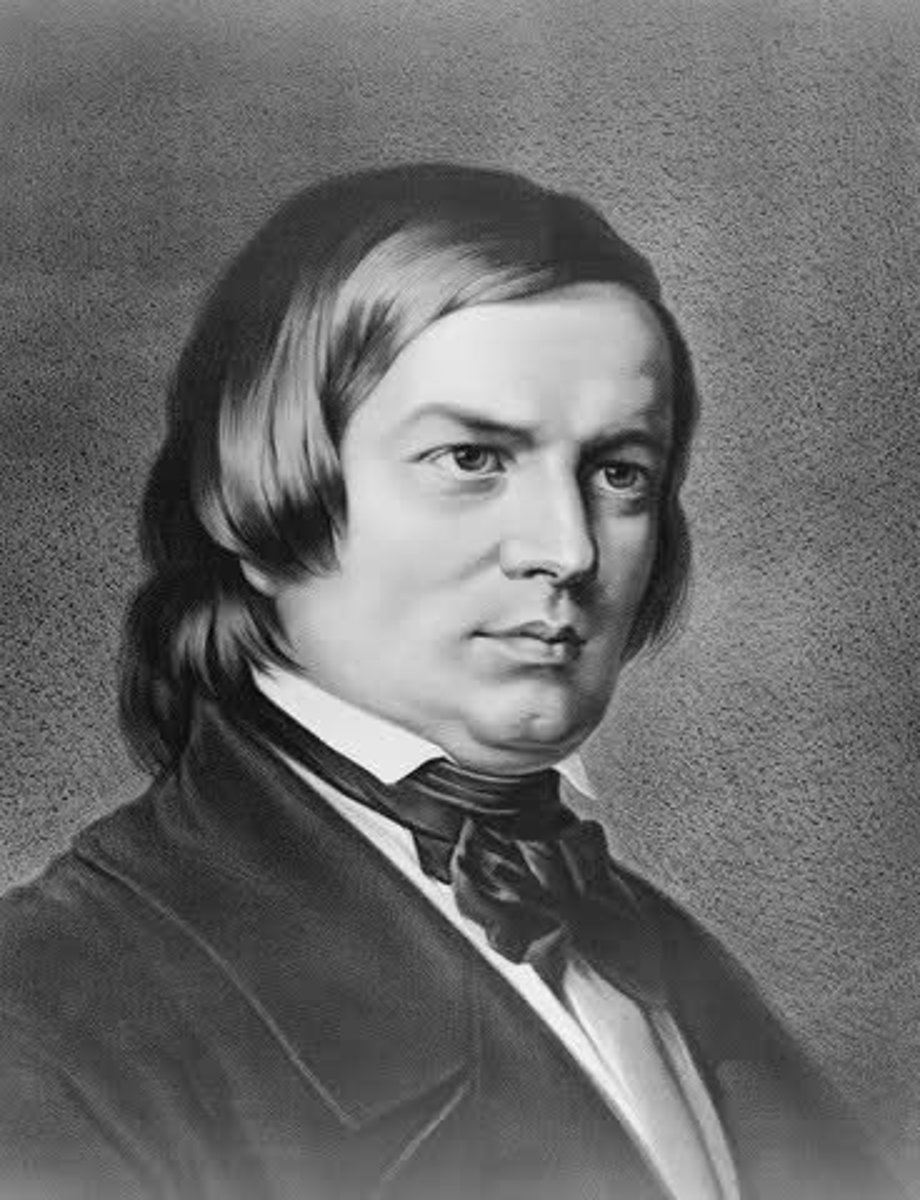MUL1010 Music Appreciation Final Exam Study Guide
1/107
There's no tags or description
Looks like no tags are added yet.
Name | Mastery | Learn | Test | Matching | Spaced |
|---|
No study sessions yet.
108 Terms
According to the text, art of the Romantic period valued emotional restraint and what else?
clarity of form and expression
Notes that don't belong to the traditional scale are known as
chromatic alterations
The dance-like characteristics of a piece indicate that it was written during which period?
Romantic
Which of the following composers envisioned operas as "musical dramas"?
Richard Wagner
Were changes in tempo rarely found in music of the Romantic period?
No; false
According to the text, who/what were the Traditionalists of the Romantic era?
Traditionalists were composers of the Romantic era who held reverence for the music of the masters
Which characteristics help you identify a composition by Paganini?
incredibly fast and complicated musical passages; extremely difficult pieces only he can play; virtuoso; violinist
Which Romantic Period composer was considered a national hero in his homeland?
Jean Sibelius
Who were the most prominent composers from the Romantic period?
Brahms, Tchaikovsky, Schumann, Schubert, Chopin, and Wagner; also Strauss, Verdi, Liszt, Puccini, Mendelssohn
What kinds of jobs did composers have during the Romantic period, as opposed to the Medieval, Baroque, and Classical Periods?
Most composers were business persons, earning their living by performing music for specific occasions and commissions, and collecting royalties on published music
What were the important artistic products of the Romantic period?
Vincent Van Gogh's paintings
Identify accelerando and ritardando by listening.
https://www.youtube.com/watch?v=JzmO2EyQ7bs
What are the characteristics of the "mood" of the Romantic Period?
Rules and logic are less important than the free expression of human feelings. Humans can only "fully become" by exploring their inner feelings.
Identify, through listening, Chopin's Revolutionary Etude.
https://www.youtube.com/watch?v=ZpuROwy_8mg
Identify through listening Berlioz's Symphony Fantastique.
https://www.youtube.com/watch?v=ewoAW-Zyuj8
Know the characteristics of musical form in the Romantic Period.
extended phrases, overlapping beginnings and endings
Know the characteristics of Romantic Period Music
individuality of style, expressive aims, song like melodies, big orchestras, nationalism, freedom of form and design, program music, expressive tone color, dramatic contrasts of dynamics and pitch
Know who The Five were and their objective(s).
The Five were Cesar Cui, Aleksandr Borodin, Mily Balakirev, Modest Mussorgsky, and Rimsky-Korsakov; Their objective was to incorporate a wide variety of elements from Russian musical life and heritage
Know about Chopin's life, through the text
Polish composer, virtuoso pianist of the Romantic era, wrote primarily solo piano, gave only 30 public performances , supported himself by selling his compositions and teaching piano
Know what kinds of dynamics may have best expressed music of the Romantic period.
extremely soft (pianissimo) or extremely loud (fortissimo) sounds; gradual increasing (crescendo) and decreasing (diminuendo)
Who were the nationalist composers of the Romantic Period?
Tchaikovsky, Rimsky-Korsakov and The Five, Smetana, Dvořák, Grieg, Chopin, Sibelius
Johannes Brahms

Pyotr Ilyich Tchaikovsky

Richard Wagner

Franz Schubert

Robert Schumann

Frederic Chopin

Béla Bartók

Who was the Romantic composer who was a musical genius, but with strong anti-Semitic views?
Richard Wagner
Who was an important Romantic composer who founded the New Journal of Music?
Robert Schumann
Identify the sound of a Renaissance consort through listening.
https://www.youtube.com/watch?v=cFid-6nC4n0
What was a Renaissance madrigal? Was it a sacred music form or secular music form?
Madrigals were secular works for a cappella choral ensembles; it was a secular music form
The course places the Romantic period in music between the years____ and ____.
1820 and 1910
During the Renaissance, what was the name composers gave to the original chant used as the basis for the main melody in a composition?
Cantus firmus
Know who was Josquin Desprez (Renaissance) and his importance in music history.
Josquin Des Prez was a Franco-Flemish composer of the Renaissance; wrote a large number of motets; many consider him the epitome of Renaissance music
Know which events occurred in Europe and America during the Renaissance.
Europe: Protestant Reformation, publishing of Gutenberg Bible and printing press, Da Vinci paints Last Supper, Rise of the Medici Family America: Columbus discovered "The New World"
According to the text, the Renaissance period was known as a period of what?
The Golden Age of Choral Music
Know the names of the important composers from the Renaissance period
Palestrina, Byrd, Des Prez, Weelkes, Tallis, Gesualdo, Monteverdi
Know strophic form and be able to identify it by listening.
Strophic Form is a form of music in which one verse, or passage, structure is repeated over and over; https://www.youtube.com/watch?v=952w2EbbYAs
What is the textbook definition of form?
Form is the structure of a composition, the frame upon which it is constructed; organizing principle of music; form is based on repetition, contrast, and variation.
Which form is not based on the principle of repetition?
binary form
Which form is not based on the principle of contrast?
strophic form
Can composers and arrangers introduce some elements of variation in a piece of music without altering form?
Yes; true
What are the musical terms for "increasing the tempo" and "decreasing the tempo"?
increasing tempo is accelerando; decreasing tempo is ritarando
Define syncopation and when one might hear it used. Identify it by listening.
syncopation in music is the concept of playing rhythms that accent or emphasize the offbeats; https://www.youtube.com/watch?v=BUtZOuND3es
rhythm
is the placement of sound in time
beat
is the basic measure of time in music
tempo
is how fast or slow a piece of music is performed
Identify triple meter and duple meter by listening.
https://www.youtube.com/watch?v=J5eK4CFU5lE
What do the top number and bottom numbers of the time signature represent?
top numbers represent how many beats are in each measure and the bottom represents which note will represent one beat
What is the Italian term for at ease?
adagio
Tempo is an Italian universal musical term that refers to ________?
speed at which a music composition is played
Which Italian term describes moderately fast tempo?
moderato
Which Italian term describes very fast tempo?
presto
Describe Meter in music.
Meter is a set pattern of weak and strong beats in music
Define Rhythm.
rhythm is organized movement of notes in time; refers to the length or duration of individual notes in a piece of music
What is it called when a melody acquires significant importance within a given composition?
theme
Know which characteristics of a melody best describe it.
pitch, range, interval, shape, phrase
The term harmony refers to the vertical aspect of music.
true
What are double stops on the violin?
double stops is the technique of playing two notes simultaneously on a string instrument
What are two simultaneous pitches of the same letter name and pitch (e.g., C, G, or D)?
False; Two simultaneous pitches of the same letter and pitch (e.g., C, G, or D) do NOT constitute a harmony; they are said to be in unison
Do consonant harmonies usually provide a feeling of tension?
No; False
What is an arpeggio? (Harmony class) Identify one by listening.
An arpeggio is a broken chord; the notes of a chord played in succession; https://www.youtube.com/watch?v=hMZXQ87OeuU
According to the text, in rondo form, the repeating themes are separated by__________?
contrasting episodes
What are Baroque rhythmic characteristics?
steady beats and repetition
What is a recitative?
a recitative is a half-singing, half-reciting style of representing words in opera, cantata, oratorio, etc; https://www.youtube.com/watch?v=IDq4KqP7Pxs
Which Baroque group was credited with inventing the recitative?
The Florentine Camerata
What is a Baroque oratorio?
a Baroque oratorio is a multi-movement sacred work for soloist and choir intended for a concert performance
What is a Baroque sonata?
baroque sonata is a piece for solo instrument or a small group of instruments
What is a Baroque concerto?
a baroque concerto is a piece that contrasts a solo instrument with an ensemble
Who was Farinelli?
The most famous castrato was Carlo Broschi also known as Farinelli
What kinds of features may be found in Baroque music?
a focus on upper and lower tones, a focus on layered melodies, and an increase in orchestra size
Who are the most renowned Baroque composers?
Johann Sebastian Bach, George Handel, Claudio Monteverdi, Henry Purcell, Jean Baptiste Lully, Antonio Vivaldi,
In the Renaissance, vocal and choral music took center stage. Contrastingly, what kind of music took center stage in the Baroque era?
instrumental
Who wrote the earliest surviving opera—then called dramma per musica?
Jacopo Peri
Name and identify the styles of recitative by listening.
secco and accompanied recitative
In the Baroque period, the term sonata was used for musical works _______.
to be played
The dates given in the course for the Baroque Period place it between: ______ and ______.
1600-1750
What were the basso continuo and Doctrine of Affections in the Baroque period?
doctrine of affections was a theory in the aesthetics of painting, music, and theater widely used in the Baroque era
Identify monophonic, homophonic, and polyphonic textures by listening.
https://www.youtube.com/watch?v=teh22szdnRQ
In general, operatic arias of the Romantic period, for example those by Giacomo Puccini use what type of texture?
homophonic; true
What is a defining characteristic of polyphony?
independence and equality of concurrent melodic lines
Are tempo and rhythm interchangeable terms?
No; false
Does musical texture refer to how melody and harmony relate to each other?
Yes; true
What are the basic terms we use to define musical texture?
monophony, homophony, and polyphony
Which musical texture consists of a single melody without accompaniment?
monophonic music
Be able to recognize accelerando and ritardando by listening to examples
https://www.youtube.com/watch?v=JzmO2EyQ7bs
Be able to identify a fast tempo, slow tempo, and rubato tempo by listening.
https://www.youtube.com/watch?v=D5upSAO0Lm0; https://www.youtube.com/watch?v=wpwxzHxD7_Q
Identify duple meter by listening.
https://www.youtube.com/watch?v=iymXBHIPEf0
According to the text, what was the significance of Debussy's work? Identify these characteristics by listening to his music.
Debussy's work represented the first viable alternative to tonal music
What are the trends in contemporary music?
jazz influence
Which composer used Hungarian folk music in his music? Identify by listening to examples.
Béla Bartók; https://www.youtube.com/watch?v=PnSWq_1quYg
Which of the following best describes aleatory music.
music that allows for an element of chance to enter the performance
Who was Nadia Boulanger?
Nadia Boulanger was a French teacher of musical composition whose pupils included Aaron Copland, Virgil Thompson, Roy Harris, Elliot Carter, David Diamond, and many other prominent American composers
Which composer most heavily influenced the music of the French post-WWI school of musicians known as Les Six?
Erik Satie
Which composer catapulted tothe top of the 20th-century avant-garde after composing Firebird, Petrushka, and Le Sacre du Printemps?
Igor Stravinsky
Which of the 20th-century trends sought to restore order, harmony, and emotional restraint to music?
Neoclassicism
Identify atonal music by listening to examples.
https://www.youtube.com/watch?v=OGbEkgEyt8k
Which one of the following composers' style is most closely associated with that of the commercial music world known as Tin Pan Alley?
George Gershwin
Which composer wrote music for prepared piano? Identify the sound of prepared piano by listening.
John Cage; https://www.youtube.com/watch?v=N0-y8oNDLgU